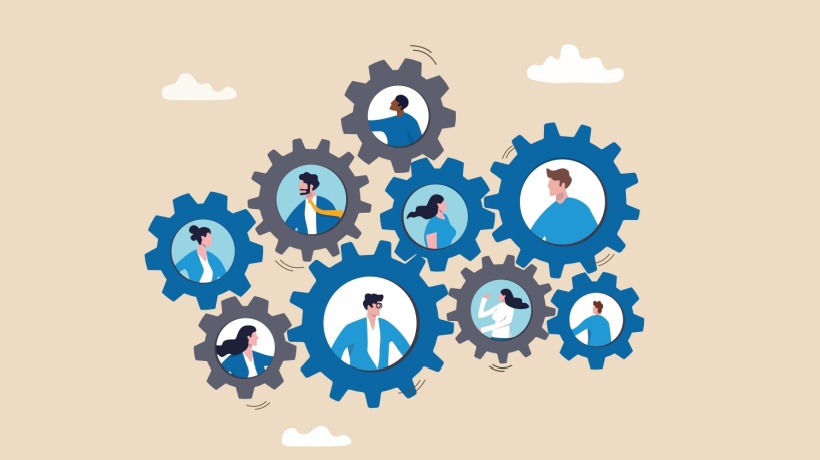Learning And Organization Development: The Organization As A Dynamic System
Organizational Behavior Theory suggests that organizations are composed of a technical core along with technical support, administrative support, and management.
- The technical core refers to people who produce the tangible products and services that are essential for the sustainability and growth of the organization. Technical support is focused on achieving goals through problem-solving, innovation, and adaptability processes.
- Administrative support provides the critical functions related to the management and development of human capital, facilities, and technologies.
- Lastly, as a separate layer, management at the respective top, middle, and front-line level undertakes in various degrees leading, planning, organizing, staffing, directing, and controlling tasks that are aimed at establishing the strategic direction and tactical coordination of inputs, transformational processes, and outputs.
Since the 1970s, in an effort to study and react to the impact of globalization, eCommerce, and other acute external pressures upon the organization, a great deal of research has substantiated a central tenet of Systems Theory: Structural components, such as departments or functions, should not be very hierarchical, nor should they exist in separate silos within the organization.
In this age of uncertainty that requires adaptability through innovation, the generally accepted consensus is that organizational components should be viewed as dynamically nimble, highly interlinked, and closely interdependent (Fig. 1). For example, Silicon Valley enterprises invest a great deal of resources towards employee engagement initiatives, organizational excellence training programs, employee and customer surveys, real-time collaboration technologies, and the integration of interconnected enterprise resource planning platforms. These efforts are aimed at bringing disparate business units together for purposes of managing change without negatively affecting revenue, employee morale or productivity. The result of these efforts can be quite compelling: As streams of communication flow from management to staff and from one department to the next, borders of previously erected silos fracture and eventually break down. Formal hierarchies become more flattened. And decisions previously made only at the top are now being influenced and even guided by input provided by front-line employees who possess technical and operational expertise.

Fig.1: Interrelated and Interdependent Organizational Structure
Organizational Performance
Organization Development (OD) uses behavioral science techniques to enhance systemic performance through which the enterprise can achieve and sustain operational goals and strategic objectives. The traditional OD tool box includes interventions such as breaking down communication barriers, building trust and collaboration, expanding employee empowerment, and implementing results-oriented job design.
This commonly accepted and often-cited definition of OD can be expanded to reflect the growing impact of two crucial components: Employee learning and knowledge management.
Employee learning refers to all learning experiences within and even outside the enterprise, including academic education, formal and informal on-the-job training, coaching and mentoring. When employee learning is added in the OD tool box, managers may come into the paradigm shift that training their staff on critical skills is not only about an immediate need to acquire a new procedure but also about cultivating one more resource: Organizational knowledge, the collective knowledge, skills and abilities that are possessed and practiced every day by the members of the organization.
Weaving employee learning into the fabric of the enterprise requires diligent planning, informed leadership, and commitment of resources, with the end result that the workforce is always skilled up and thus readily adaptable to change.
As work environments, private and public alike, are becoming more complex due to technological advances, leaders are gradually yet steadily coming into the realization that organizational knowledge has become the currency with which organizations pay their way to sustainable growth. Managing organizational knowledge means taking actions to ensure that knowledge is passed on and that this knowledge is not controlled by or available to only one person or only a few people.
Knowledge is composed of explicit and tacit characteristics. Explicit knowledge is the formal, systematic, professional expertise and know-how that can be written down and documented in various forms. Tacit knowledge is the tribal type of knowledge that is based on personal understandings, rules of thumb, intuition, and individual judgment. Explicit knowledge refers to knowing about a process or a procedure, tacit knowledge adds the element of knowing how to execute the process or procedure under a variety of circumstances. Substantive learning solutions are driven by both explicit and implicit knowledge.
To establish an impactful program of knowledge management, the first action would be to build and solidify a specific body of required knowledge, such as a set of standard operating procedures (SOPs) and then identify the need for knowing and practicing this body of knowledge. The next step would be to document this valuable information and, through training and communication processes, share it across the enterprise. Updating the specific body of knowledge is paramount to the effective implementation of this framework. Equally important is the technology that enables the organization to collect, codify, and distribute organizational knowledge on demand (Fig. 2).

Fig.2: Organizational Knowledge Implementation Framework
The combined forces of employee learning and knowledge management can build substantive value in quantitative terms as well as qualitative terms. Forward-looking organizations synthesize both components with the organization’s inputs, transformational processes, and outputs to achieve established organizational performance criteria (Fig. 3).

Fig.3: Organizational Performance Matrix
End Notes
Data can be viewed as raw and unorganized facts and figures which, by themselves, are of little or no use. Information is data that has been converted into a context-specific and inter-linked scope of skillful practices. Knowledge is information that has been absorbed and then put to use by a person or persons. Thus, in the knowledge organization, every employee’s job is designed, learned, and practiced as a multi-dimensional contribution to the organization’s objectives. The challenge for training professionals is twofold: Improve the organization through employee learning. And, add value to the organization by capturing, disseminating, and sustaining organizational knowledge.








